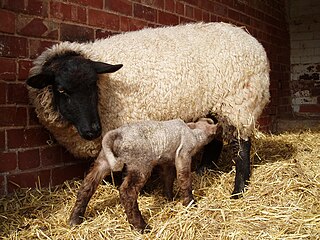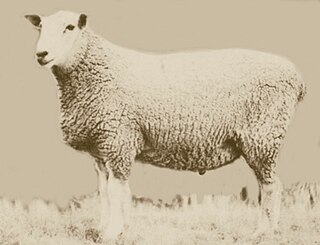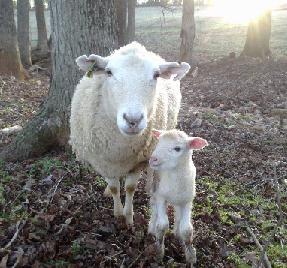Related Research Articles

The Navajo-Churro, or Churro for short, is a breed of domestic sheep originating with the Spanish Churra sheep obtained by Navajo, Hopi and other Native American nations around the 16th century during the Spanish Conquest. The breed is renowned for its hardiness and adaptability to extremes of climate. Its wool consists of a protective topcoat and soft undercoat. Some rams have four fully developed horns, a trait shared with few other breeds in the world. The Navajo-Churro has also gained popularity for its low-maintenance reputation, resistance to disease, and lean meat. Some say they are very personable. Ewes often birth twins. This breed is raised primarily for wool.

The Border Leicester is a British breed of sheep. It is a polled, long-wool sheep and is considered a dual-purpose breed as it is reared both for meat and for wool. The sheep are large but docile. They have been exported to other sheep-producing regions, including Australia and the United States.

The Jacob is a British breed of domestic sheep. It combines two characteristics unusual in sheep: it is piebald—dark-coloured with areas of white wool—and it is often polycerate or multi-horned. It most commonly has four horns. The origin of the breed is not known; broken-coloured polycerate sheep were present in England by the middle of the seventeenth century, and were widespread a century later. A breed society was formed in 1969, and a flock book was published from 1972.
The Finnish Landrace, Finn or Finnsheep is a breed of domestic sheep native to Finland. It is one of several Northern European short-tailed sheep breeds, but is notable for its high incidence of multiple births – it is common for a ewe to have three, four, or even five lambs at once.
The Polypay sheep breed is a white, medium-sized, polled sheep which was developed in the 1960s at the U.S. Sheep Experiment Station in Dubois, Idaho. In general, Polypay sheep are noted for being a highly prolific maternal dual-purpose breed. It produces yearly about 4.2 kg of wool and is weaned at 120 days.

The Shetland is a small, wool-producing breed of sheep originating in the Shetland Isles, Scotland, but is now also kept in many other parts of the world. It is part of the Northern European short-tailed sheep group, and it is closely related to the extinct Scottish Dunface. Shetlands are classified as a landrace or "unimproved" breed. This breed is kept for its very fine wool, for meat, and for conservation grazing.

The St Croix is a breed of domestic sheep native to the U.S. Virgin Islands and named for the island of Saint Croix. They are often also called Virgin Island White because those that were imported into North America were selected for white coloration. On the Island of St. Croix, they come in shades of brown, white and black.

The Charollais is a breed of domestic sheep originating in east central France, in the same region in which Charolais cattle originated, Charolles and Saône-et-Loire. It is known for ease of lambing and is used as a terminal sire to increase muscling and growth rate of the lambs. It has been exported internationally, and is commonly used in the United Kingdom as a sire to produce market lambs from pure-bred ewes and mules.

Domestic sheep reproduce sexually much like other mammals, and their reproductive strategy is furthermore very similar to other domestic herd animals. A flock of sheep is generally mated by a single ram, which has either been chosen by a farmer or has established dominance through physical contest with other rams. Most sheep have a breeding season (tupping) in the autumn, though some are able to breed year-round.

Sheep or domestic sheep are domesticated, ruminant mammals typically kept as livestock. Although the term sheep can apply to other species in the genus Ovis, in everyday usage it almost always refers to Ovis aries. Like all ruminants, sheep are members of the order Artiodactyla, the even-toed ungulates. Numbering a little over one billion, domestic sheep are also the most numerous species of sheep. An adult female is referred to as a ewe, an intact male as a ram, occasionally a tup, a castrated male as a wether, and a young sheep as a lamb.

The Lacaune is a breed of domestic sheep originating near Lacaune in southern France. The native region of these sheep is the Tarn and Aveyron departments and surrounding areas. This region is collectively known as the "Roquefort Sector" which references the milk collection area. The Lacaune is the most widely used dairying sheep breed in France, with a population of about 800,000 ewes. Notably, it is the predominant breed used in the production of Roquefort cheese in France.

The Llanwenog is a breed of domestic sheep originating in Wales. It was developed in the 19th century from the Llanllwni, the Shropshire, Welsh Mountain, and Clun Forest breeds. The Llanwenog's native locale is the Teifi Valley, in western Wales, but it has since spread into other areas. The breed association was formed in 1957. Llanwenogs have black faces and medium-length wool. They have a docile temperament and are known for their profligacy in lambing. The breed has a very placid temperament, is easily handled, easily contained and is well suited to stress free inwintering if necessary. This has important consequences for the health of both the animal and its keeper. This breed is raised primarily for meat.

The Dalesbred is a breed of domestic sheep originating in England. Derived from the Swaledale and Scottish Blackface breeds, the Dalesbred is a northern hill breed distributed in the Yorkshire Dales and into Lancashire. The Dalesbred is genetically distinct from the other northern hill breeds, the Herdwick and Rough Fell.

The Beulah Speckled Face is a breed of domestic sheep originating in the United Kingdom. Having been bred in the uplands of Wales for more than a hundred years, a breed society was officially formed in 1958. This breed is most common in Eppynt, Llanafan Fawr, Abergwesyn, and Llanwrtyd Wells, and it is little known outside Wales. The origins of the breed are unclear; it may be a truly native breed that has been selected to suit the local environment for centuries. The breed is named for its distinctly patterned black and white face, which is free from wool. The ewes, which are naturally polled, are often crossed with lowland rams such as the Suffolk, Texel or Bluefaced Leicester to breed mules, and to produce market lambs for meat. When bred pure, the lambs do not meet today's export demand for lean, fast-growing sheep. However, the ewes make good mothers and produce plenty of milk.

Algerian Arab sheep is a breed of domesticated sheep found throughout Algeria. This breed does grow a carpet-grade wool, and is raised primarily for meat.
The British Milksheep is a robust, dual-purpose sheep commonly known for its milking characteristics.

The Coburger Fuchsschaf is a breed of domestic sheep from Germany. It is characterized by its reddish brown to golden color, which is most pronounced at birth, but remains at the head and the legs in the adult. Many animals also have a dorsal stripe.

The Canadian Arcott is a breed of domestic sheep native to Canada. The latter half of its name is an acronym for the Animal Research Centre in Ottawa, where it was developed along with the Rideau Arcott and the Outaouais Arcott. This breed was a result of a crossbreeding program of Suffolk (37%), Ile de France (28%), Leicester (14%), North Country Cheviot (7%) and Romnelet (6%); the remaining 8% was contributed from Shropshire, Lincoln, Southdown Dorset, East Friesian, Finnsheep and Corriedale.

Gromark sheep are a large-framed, plain bodied dual-purpose breed of sheep that were under development in 1965 by Arthur C. Godlee at "Marengo", Tamworth, New South Wales. They were selected for a high growth rate, fertility, wool quality and carcase attributes.

The Polled Dorset is an American breed of domestic sheep. It is a polled (hornless) variant of the British Dorset Horn. It was developed at the North Carolina State University Small Ruminant Unit in the 1950s after a genetic mutation led to the birth of a polled ram. After some years of breeding work, a true-breeding polled strain was established.
References
- ↑ Fahmy, M.H. (1993). "DSL and Arcott Sheep New Canadian Breeds" (PDF). Agriculture Canada. Retrieved December 2, 2016.
- 1 2 3 4 "Breeds of Livestock - Rideau Arcott Sheep — Breeds of Livestock". Department of Animal Science. Retrieved 2016-12-03.
- ↑ Shrestha, J. N. B; Heaney, D. P (2003-07-01). "Review of Canadian, Outaouais and Rideau Arcott breeds of sheep: 1. Development and characterization". Small Ruminant Research. 49 (1): 79–96. doi:10.1016/S0921-4488(03)00070-1.
- 1 2 Ekarius, Carol (2008). Storey's Illustrated Breed Guide to Sheep, Goats, Cattle and Pigs. Storey Publishing. ISBN 978-1-60342-036-5.
- 1 2 "Rideau Arcott". Medicine Ridge Ovine. Retrieved 2016-12-03.
- ↑ "Rideau". Sheep 101. 2012-04-24. Retrieved 2015-08-16.